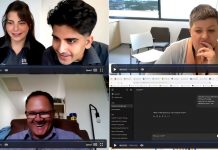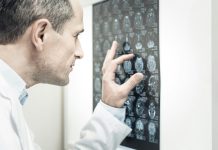
Every year, more than 795,000 people in the United States have a stroke.
Of these, approximately 80% lose arm function and as many as 50-60% of this population still experience problems six months later.
Traditionally, stroke patients try to regain motor function through physical rehabilitation, where patients re-learn pre-stroke skills, such as eating motions and grasping.
However, most patients eventually plateau and stop improving over time.
In a new study from the University of Southern California, researchers found patients who received a novel treatment that combines vagus nerve stimulation (VNS) and rehabilitation showed improvement in upper body motor impairment.
Considered a natural antenna to the brain, the vagus nerve runs from the chest and abdomen to the brainstem and regulates many of the body’s functions.
These results are the first of their kind, and open up new possibilities for stroke patients, allowing them to reclaim more arm function even years after having a stroke.
In the study, the team examined 53 participants with moderate to severe arm weakness nine months to 10 years post-stroke, who received rehabilitation paired with VNS.
Those receiving the nerve stimulation had a wire inserted into their neck that wrapped around the vagus nerve.
The wire was then connected to a pulse generator device implanted in the chest. Those receiving the sham received placebo implants.
After the surgical procedure, all patients received six weeks of in-clinic therapy, which included tasks such as reaching and grasping, simulated eating and opening and closing containers.
After the in-clinic period, patients continued treatment with a course of daily home therapy.
When the two patient groups were compared, the team found those receiving the nerve stimulation scored higher on several standardized measures of upper arm functionality.
The team says not only were the results clinically meaningful, the fact that these patients were at least nine months post-stroke and in some instances years out, points to the possibility that meaningful improvements can be achieved even years after a stroke.
The device is thought to work by triggering the release of brain neuromodulators—which regulate the body’s responses—to strengthen motor circuits in the brain associated with movement, enabling the brain to effectively relearn tasks.
VNS is already used widely for the treatment of epilepsy and plays an increasing role in the treatment of severe depression.
If you care about stroke, please read studies about this blood thinner drug plus aspirin could strongly reduce stroke risk and findings of these food may reduce your stroke risk.
For more information about stroke prevention and treatment, please see recent studies about avoiding these foods can lower your heart disease, stroke risk and results showing that people need to stop using aspirin to prevent first heart attack, stroke.
The study is published in The Lancet. One author of the study is Charles Liu, MD, Ph.D.
Copyright © 2021 Knowridge Science Report. All rights reserved.



